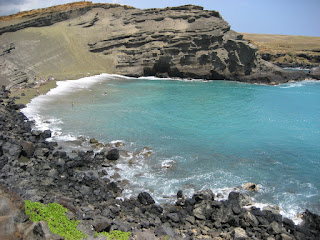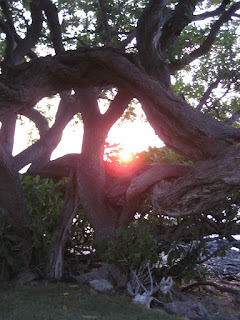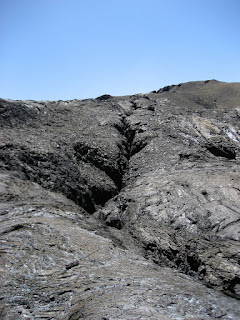An integral part of HVO's work involves monitoring the lava flows, ocean entries and vent of Pu'u O'o -- the active part of Kilauea. Lava is no longer erupting from the crater, but has moved down the fault line to the southeast. The fault line is spotted with old craters and vents from previous eruptions, but has been erupting at Pu'u O'o since 1983. Every other week, Tim, the main Kilauea physical volcanologist on staff (and Tyler's supervisor) flies out in a hired helicopter to photograph the flows and vent to determine where the current breakouts are and keep an eye on the vent and its structure at Pu'u O'o. Every volunteer is guaranteed at least one helicopter ride and my card came up this past Thursday.
I was accompanied by Brendan, a short term volunteer, on our helicopter journey. We got all decked out in military green flight suits and huge flight helmets and gave ourselves flight names (Nene - a bird here, and Ohelo - the berry they eat). Our helicopter has the doors removed so Tim can get better pictures as well as allow for more gear to be carried. We headed out to the coast line via a seismic station that needed a new battery and a quick jaunt over Pu'u O'o to determine the best landing site. At the coast line, David, the pilot, flew over the ocean entries and then back towards the pali (cliff/hill) to search for the highest breakout of lava location. Lava travels from Pu'u O'o in lava tubes and then breaks out along the pali and down at the coast. Breakouts can occur almost anywhere along the tubes, so every week Tim samples lava from different locations. Sampling involves finding an active break out, smashing at the red, viscous lava (its like really thick maple syrup) with his hammer and depositing the sample instantly in to tin can filled with water. This instantly quenches the lava and allows him to analyze the exact chemical composition of the lava before it starts to partially crystallize.
After sampling, we got back in the helicopter and went back up the pali to the vent. David dropped us off with promises to return in 2.5 hours to pick us up. Our mission for the day was to remove a camera located in a precarious spot, photo-document the vent and any new rock, replace a tripod for one of the main cameras and collect Pele's tears (tiny pieces of basaltic/lava glass that few out of the vent and form in teardrop shapes). Tim was careful to keep an eye on Brendan and I as well as inform us of what was newly formed rock. My favorite moments were when we walked over an active lava tube that was smoking and had a lava break out 5m away the past week and then later, when the vog was so thick that you could not see 3m in front of you. We did a full loop around the vent before returning to wait for the helicopter.
The highlight of the trip was when we got to peer in to East Pond Vent. As we approached, it sounded like we were walking up to the ocean during a violent and raging storm. Careful not to get too close to the edge, we looked over and saw an active lava lake! The surface was 20m down and bright red with lava slamming against the walls. Part of the surface had already cooled and turned to black basalt, but we had a perfect angle to see the deep red fly around.
Now I will post about 1/4938 of the photos Brendan and I took, combined.
Later this week I will ride in the helicopter again, but this time around the summit of Mauna Loa. Up there, the helicopter can only hold one passenger because the air is so thin!

Ohhhh yeah. Top gun?

Elliptical shape in top right is a shatter ring -- it inflates and deflates with lava and gas. This is the current ledge; the darker grey is the current flow spilling over the edge.

Close up of ocean entry. Last week park rangers had to remove a couple who were camping on the beach . . . I cannot even comment on it.

Our helicopter waiting on the lava flows while we get a sample.

Tim in his full body protection suit collecting a red hot sample with his trusty Maxwell House Coffee can waiting with water.

Two of the three entries.

A road to nowhere.

Royal gardens on fire.

Pu'u O'o! The gas does not smell good, makes you cough and your eyes run. Gas masks and sunglasses are a must.

I am sooo cool. That suit does not breathe well.

Hmmm, something tells me this equipment no longer works.

Tim on a mission to get some photos. The low level steam is coming from an active tube that we will later walk over -- 5 m from a skylight (open top of tube).

The lava right below the steam is a new breakout! It is rare to find a surface flow near Pu'u O'o.

Trekking in to the vog and unknown. Yeah, I did a perfect slide in to 3rd base during this walk.

Recording some data as Tim takes the alignment and measurements of the camera.

The most amazing sight ever -- lava lake!








































